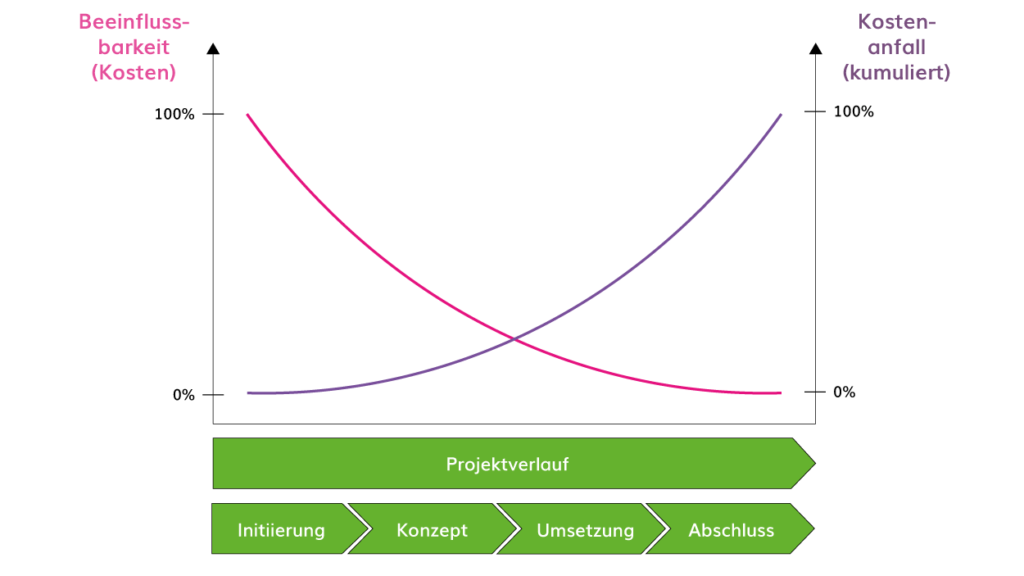Indeed: the decisive course for project success is set at the beginning. What goes wrong here often can’t be corrected anymore or only painfully so. Because the rule of diminishing influence applies: before the project start, both the costs and the planned benefits from the project are still 100% influenceable. The further the project progresses, the less the wheel can be turned back: The detailed planning is eventually completed, purchases are made, the project team has invested a lot of time, expectations are high. If the project then stalls, deadline and cost targets are far exceeded, or even a new start is necessary, the disappointments are great and the reputation with customers is endangered. To prevent it from getting that far, here are five recommendations from digatus with which you can set your project on the right track from the beginning.
Influenceability of costs during the project course (model representation)
1. Clarify the Project Context and Stakeholders
Who is the client, who is possibly the external customer? Who are the users, who needs to be involved internally or externally as a supplier or service provider for the project? What other stakeholders are there within and outside the company? Which user groups and which experts do you need to involve intensively? What is the relationship of various stakeholders to the project? How can you shape these relationships positively or constructively? Use the stakeholder analysis as a tool and develop measures for communication, coordination, and involvement of the respective stakeholders for the further course of the project, the foundation for the project communication plan.
2. Identify and Carefully Check the Project Goals Early On
Unclear project goals or inadequate documentation of such goals are seen by experienced project managers as the problem with the strongest negative impact on project success. Therefore, check: Are the goals consistent in themselves, are they in line with the company or department strategy? Do you use brainstorming tools like mind maps or the goal cross? Do you use methods like SMART or MoSCoW to identify, measurably and realistically define, and prioritize the goals in the circle of stakeholders? Keep the results in a written table as a binding goal definition and integrate them into the project charter.
3. Anchor the Project Planning to the Planned Results
One of the advantages of PRINCE2® is its product focus, which derives all activities and plans from what results (in the form of processes, applications, training, operational concepts, etc.) the project should realize. But other project methods also know the “specification of services” or the “requirements specification” as documents that precisely define what should be created as a project result and in what quality. Ensure that these project products are defined in detail, precisely, and measurably before resource and process planning begins. Ask yourself: Can we realize the desired benefits with the planned project products? Are the quality requirements described precisely enough? Ideally, documents such as the product or service description serve as tools. There, completion dates, standards to be adhered to or quality requirements, test and acceptance responsibilities can be stored as well as necessary preliminary products.
4. Clearly Define the Roles in the Project
Unclear tasks and responsibilities lead to misunderstandings, friction losses, and more or less openly conducted conflicts in the project and towards stakeholders. Important tasks are neglected, while at the same time there are recurring disputes over responsibilities for other issues. Perhaps you have already introduced uniform project management standards and thus clear project roles in your company. If not, you should clearly define for your individual project which tasks and responsibilities lie with which project participant. Make the relationships as unambiguous as possible: Project management should be assigned to only one person and not to a team or even a committee. The role of project manager and client should not be held by the same person. It is important to clearly agree on the necessary scope for action and decision-making and communicate this to all parties involved. For example: What can the project manager decide on their own? When must they escalate emerging problems or risks? Which process regulates decisions on change requests? Which decisions are reserved for the steering committee? These questions should be clarified at the latest with the project charter.
5. Verification and Securing of Necessary Resources
Whether you rely on your own or external project managers and service providers: a binding commitment of resources for the planned period is necessary, but also presupposes reliable time planning. Therefore, ensure that the project is carefully planned, dependencies are considered, and time buffers are built in. Ask: Are the designated persons reliably available during the planned time? Are other projects running at the same time that need to access the same ‘key’ people? If so, how is the risk of overload reduced?
And finally: The people who take on important tasks in the project must be appropriately experienced. Unfortunately, it is also not a given that they will be sufficiently released from other tasks. You may be able to count on a certain degree of flexibility and increase in the normal workload of your team. In any case, you should make sure that you do not overstrain the overall performance of your organization. If you regularly realize several larger projects in parallel with the same people, it is recommended to use project management software that allows you to effectively plan and manage resources and tasks.

Hannes Götz
Since mid-2018, he has been part of the digatus team. Initially starting as a Junior Consultant, he now supports our clients in his current role as Senior Consultant in digital transformation projects - mainly in carve-outs and integrations in the private equity sector. He benefits from his accumulated experience in leading workstreams and (sub)projects, both in global corporations and small companies, as well as his solid technical background from working as an IT system administrator. Over the years at digatus, he has specialized in the areas of infrastructure & rollout.





